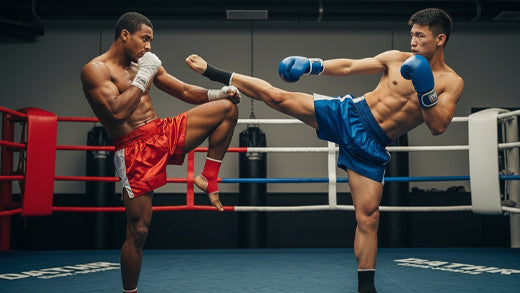As an athlete or fitness enthusiast, understanding stamina vs endurance influences your training, recovery, and performance. At Sting Sports, we know that being fit is not what a champion is all about; an actual champion possesses the explosive power of stamina and the invincible determination of endurance.
Let's explore the core definitions, clarify the difference between stamina and endurance, and outline specific training techniques that incorporate our high-quality equipment to make you a well-rounded athlete.
What Is Stamina?
Stamina refers to your ability to maintain high-quality effort and intensity near your maximum limit without becoming fatigued, distracted or losing form and focus. People commonly refer to stamina as their body's resistance against exhaustion during anaerobic (non-oxygen-dependent) work, the powerful short-term system.
-
Focus: Intensity and Quality of Output.
-
Application: Throwing a fast, powerful combination in the final minute of a round.
-
Key Question: How long can I sustain my highest performance level?
What Does Endurance Mean?
Endurance is the ability to sustain a physical activity over a prolonged period of time at a moderate-to-high level. It relies primarily on the aerobic (oxygen-dependent) system. It is composed of both cardiovascular endurance (how efficiently your heart and lungs function) and muscular endurance (how long a specific muscle group can continue to work).
-
Focus: Duration and Consistency of Pace.
-
Application: Completing a 10K run or going the distance for a 12-round fight.
-
Key Question: How long can I sustain this effort before I must stop?
In simple terms, stamina is about maintaining power, while endurance is about maintaining time. To achieve proper fitness with Sting Sports gear, you must train both.
Stamina vs. Endurance: The Key Difference
To better distinguish stamina vs. endurance, consider the example of a fighter using a punching bag workout and a cyclist engaging in a climb.
-
A boxer performing rapid, high-power combinations on a punching bag demonstrates stamina; they rely on short bursts of explosive energy to maintain speed and force.
-
Meanwhile, a long-distance cyclist showcases endurance; their goal is to sustain consistent effort and pacing over an extended period without exhaustion.
Energy Systems: The Real Difference.
The ultimate difference between stamina and endurance is the systems of energy that your body consumes to perform an activity.
-
Stamina is Anaerobic: The burst of explosive power that the boxer consumes is supplied by the anaerobic system (in other words, without oxygen). This system delivers high power but wears out easily. This is the reason stamina is needed in short, max-effort bouts. If you are wondering, does running increase stamina? Short, high-intensity runs do.
-
Endurance is Aerobic: The bicycle rider uses the aerobic system (that is, with oxygen). This system takes into consideration the effective use of oxygen to break down fuel, ensuring a steady and sustained pace. This system is the foundation of endurance, which is commonly subdivided into two essential parts:
-
Cardiovascular Endurance: Refers to the efficiency of the heart and lungs in delivering oxygen to the working muscles.
-
Muscular Endurance: This is the skill of a certain muscle group to contract repeatedly without failing.
Understanding these systems will help you create more effective workout plans, leading not only to short-term explosiveness but also to long-term sustainability.
Applying the Science: The Dual Training Strategy
To effectively build stamina and endurance, your workout routine must specifically target both energy systems. This is crucial for becoming a complete athlete.
Sustained, steady-paced efforts, such as long-distance cycling, are crucial in developing cardiovascular endurance, whereas incorporating high-intensity variations is essential for developing explosive stamina.
Sprint repeats are one of the best exercises for building stamina because they require pure anaerobic effort that pushes your high-intensity capacity. By including both high-intensity bursts and sustained efforts, you ensure maximum improvement in both stamina and endurance.
|
Fitness Goal |
Training Type |
Key Characteristics |
Training Examples |
|
Stamina |
Anaerobic / Power Work |
High Intensity, Short Duration, Minimal Rest. |
HIIT, Hill Sprints, Heavy Bag Work (Max Power Combos), Burpees. |
|
Endurance |
Aerobic / Sustained Work |
Moderate Intensity, Long Duration, Consistent Pace. |
Long-Distance Running, Cycling, Swimming, Light Bag Work (Continuous Flow), Planks (Long Holds). |
|
Hybrid |
Circuit / Cross-Training |
Alternating intensity to challenge both systems simultaneously. |
Jump Rope Exercises (Alternating fast sprints with moderate pace), Circuit Training with minimal rest. |
Training Methods: How To Increase Stamina And Build Endurance
Regardless of the sports you are training for, tailoring your training to build both endurance and stamina will help you last longer before fatigue sets in and give you the power to push through.
Here are the proven ways to train smarter for both:
1. Focus on Low-Intensity Training
Best for: Cardiovascular Endurance
It might sound contrary, but the solution to maximizing your foundation is to reduce speed. Spend about 80% of your weekly activity in heart rate Zones 1-2 (conversational effort). This improves your aerobic engine, which means that your body burns a significant amount of fat, utilizes it as a source of energy, and delays fatigue.
2. Lift Lighter, High-Volume Sets
Best for: Stamina & Muscular Endurance
To maximize durability, train with reduced resistance (40–60% of 1RM) across extended repetition ranges (12–20+ reps). These conditions are vital for the slow-twitch fibers that are essential for endurance and boost capillary density, which significantly enhances your stamina. This improved muscular endurance is critical for sustaining effort when exhaustion sets in.
3. Add In Some Interval Training
Best for: Stamina
Interval training (HIIT) involves short bursts of high-intensity effort followed by short recovery periods. Sessions featuring sprinting or Jump Rope Exercises help your body's capacity to use oxygen and improve fatigue resistance. These stamina exercises help you to generate rapid power when needed, while effectively contrasting endurance vs stamina demands.
4. Apply Progressive Overload
Best for: Stamina & Endurance
The body improves only when challenged. Progressive overload ensures this by increasing volume, load, or speed. Higher repetition training enhances both muscular endurance and aerobic endurance, while consistently growing intensity leads to better running metrics, allowing athletes to reduce race times while maintaining sustainable performance levels effectively.
5. Prioritize Smart Nutrition
Best for: Stamina & Endurance
Diet can have a dramatic impact on both stamina and endurance. Carbs fuel sustained/intense sessions by replenishing glycogen stores, while protein helps repair muscles. Proper hydration with adequate electrolyte levels is equally crucial; fluid loss can drastically decrease performance in all activities.
6. Commit to Consistency
Best for: Stamina & Endurance
Gaining higher endurance and stamina cannot be achieved overnight; these attributes require regular practice. Maintaining a schedule and receiving proper training will result in improvements in stamina, fatigue resistance, and a solid foundation for achieving maximum potential.
The Final Word
Ultimately, the confusion over "is endurance and stamina the same thing?" is cleared when you see them as complementary forces. Stamina provides short bursts of strength when needed, while endurance acts like an energy reserve that ensures you remain upright after others have given up. Mastering the dynamics of stamina vs endurance is the cornerstone of maximum performance.
Great athletes don't only possess either endurance or stamina; they strategically train for both. Sting Sports provides high-quality gear, allowing you to maximize your stamina and endurance in exercises that focus on controlling the pace of each challenge you encounter.
FAQs
Q1.What are the best stamina exercises?
High-intensity workouts, such as jump rope intervals, sprints, and punching bag drills, are excellent exercises for building stamina.
Q2. What is the fundamental difference between stamina and endurance?
Stamina is the ability to sustain maximum intensity and power output (quality) for a short time span. Endurance is the capacity to maintain a steady effort (longevity) during a long-term period.
Q3. Does running enhance stamina and endurance equally?
No. Long, slow runs develop endurance (aerobic base). To develop stamina, you need to perform intense stamina exercises such as sprints and intervals (anaerobic activities).




